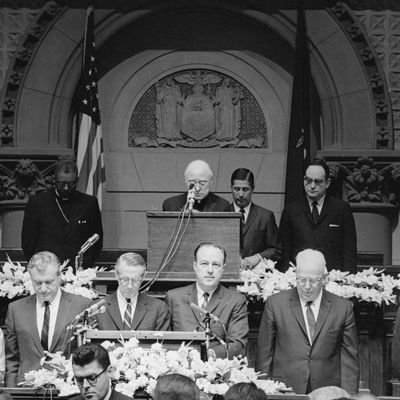
Like the periodical cicada, but on a longer cycle, a New York ballot initiative recurs automatically every 20 years: a constitutionally required referendum on holding a full-fledged, open-ended constitutional convention.
For a while there it looked like New York might hold its third Con Con (shorthand for a constitutional convention) under the referendum procedure. The first, in 1938, produced several constitutional amendments making it possible for state government to deal with the social-welfare needs of the Depression, and for New York City to borrow money for expansion of the subway system. The key amendments were subsequently approved by voters. A referendum called by the legislature in 1965 after an extended deadlock over redistricting was approved by voters. The package of recommendations that ended up coming out of the convention were voted down in November of 1967, mostly because of opposition to a provision that might have paved the way to public funding for religious schools.
Con Con referenda were subsequently voted down in landslides in 1977 (by a 60–40 margin) and in 1997 (by a 63–37 margin). Unions invested heavily in defeating the 1997 referendum out of concern for vulnerable collective-bargaining rights and public employee benefits.
The 1997 experience appears to be replicating itself this year. Early polls showed solid public support for calling a Con Con, via Proposal 1; in July, Quinnipiac found voters supporting it by a 55–30 margin, with underlying sentiment favoring constitutional amendments to make redistricting nonpartisan and to guarantee a right to abortion.
Advocates — many of them progressives — with a variety of grievances against the status quo in Albany consider the Con Con a way around entrenched interests in the Empire State who are fighting change. But heavy advertising largely financed by unions and opposition from key opinion leaders appear to have turned the tide of public opinion.
There are two particularly good reasons for buyers’ remorse regarding the progressive potential of a constitutional convention.
First, as Bob Master points out at The Nation, delegates to the constitutional convention would not be elected in an especially representative manner:
Delegates to the constitutional convention will be elected predominantly from State Senate districts — three delegates each from the 63 State Senate districts (15 delegates will also be elected at-large from across the state). These districts were expressly drawn by New York’s Senate Republican majority in 2011 to safeguard their power.
Second, the election for these delegates would be held in November of 2018, the same time as crucial midterm elections. Wealthy special interests would almost certainly spend heavily to protect themselves (and perhaps to advance their policy goals aggressively) in the delegate elections, displacing progressive resources better spent on statewide congressional and legislative contests. The New York Times, which supported a Con Con in 1997, cited the current campaign-finance rules and a capricious political climate as reasons for voting no:
The United States Supreme Court’s 2010 ruling in the Citizens United case opened the floodgates to limitless campaign cash from ill-intentioned characters determined to twist public opinion for their own benefit. Britain’s Brexit vote and Donald Trump’s election in 2016 demonstrated the ascendance of demagogy and fearmongering. In this climate, the danger of a hack-filled convention going haywire is palpably greater than it was two decades ago.
And though they are not connected in any meaningful way, there are some fears a Con Con in New York would help pave the way to a federal constitutional convention that conservative activists (backed by the Koch Brothers) are trying to call in order to put permanent limits on government directly into the U.S. Constitution.
In any event, the tide seems to have turned on Proposal 1: A late poll from Siena College showed the initiative failing by a 25–57 margin. (An earlier Baruch College poll showed a very large undecided vote that turned positive after voters heard arguments for a Con Con, but it’s not clear that they’ve actually heard them). It seems that in the end, frustrations with the creaky mechanisms of democracy are giving way to legitimate fears about the consequences of shortcuts. For progressives, that may be partially a function of the example being set every day by the supreme short-cutter in Washington.






























